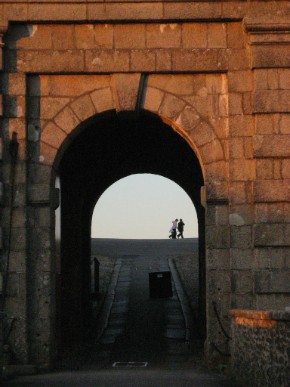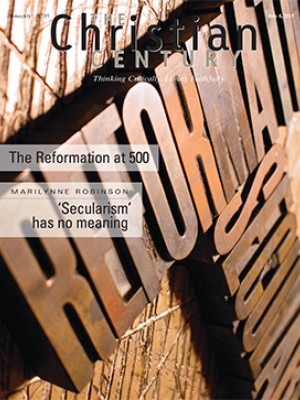Stories of my childhood
I’m short on retrievable memories from my childhood, but there have been a few memories I thought I might recover if only I could track down certain books. I began by searching out Crockett Johnson’s Harold and the Purple Crayon. That was easy. It’s still in print and still brings back the feeling I had, when drawing pictures from imagination, of whole worlds appearing ex nihilo from a few penciled lines. I suspect that may have planted a seed of interest in the idea of creation.
An even more exciting find was Crockett Johnson’s masterpiece, the Barnaby series he contributed during the 1940s to the left-leaning newspaper PM. While Dr. Seuss was drawing anti-isolationist cartoons for the same newspaper, Johnson chose to render—in his characteristic clean black lines—the inner life of a young child, Barnaby Baxter, whose stable American suburban home is ruffled by air raid drills, scrap metal drives, rationing, and other intimations of a world under siege. Barnaby is a practical boy, but he needs adventure as much as reassurance; and both needs are met by a slightly disreputable fairy godfather, Mr. O’Malley, whose magic wand is a Havana cigar, whose favorite expression is “Cushlamochree!” and whose compatriots include an invisible leprechaun and a timid ghost. Barnaby’s parents, as well as the orthodox Freudian psychologist they consult, are convinced that O’Malley is a compensatory fantasy. But Barnaby—and we—know better; and I was the better for seeing how matter-of-fact one can be when faced with challenges to faith.
Read our latest issue or browse back issues.
Then there was the Little Golden Book whose title I had misremembered as Crispin’s Crispian: The Dog Who Loved Strawberries. In fact, it was the last book produced by Margaret Wise Brown (of Goodnight Moon fame), under the title Mister Dog. One has to look within to discover that its subject is Crispin’s Crispian—a dog so named because he belongs to himself—who has a liking for strawberries and for a well-ordered life. I’m pretty sure I loved that book because I was an only child, belonging (so I thought) to myself. And when a little boy, who also belongs to himself, ends up moving in with Crispin’s Crispian because they understand each other so well, the implication is clear: one can have solitude without isolation, and tranquillity in fellowship.
All this work of recovery has been a mere prelude, however, to the most poignant discovery of all. I had only a picture-memory to go on—difficult to translate into search engine language—of a man discovering by trial and error how to build a secure arch. After years of searching, I found the book last month: The Magic Stones, published in 1957 by “Alain”—a pseudonym for the New Yorker cartoonist and painter Daniel Brustlein. I wish I knew how to convey the subtle power of the lines and shapes, and the enchantment they worked upon me. Yet what I find curious is that I had completely forgotten what a religious book it is. It begins and ends in church, telling the story of the Cathedral of Notre Dame de Paris and of the conquest of “Monsieur Down”—the spirit of gravity who delights in reducing churches to rubble—which made this cathedral and its forerunners possible.
What captivated me, though, was not the towering spires, flying buttresses, and chimera of the cathedral, but the moment (we are told the year is AD 600) when a young man first places stone upon stone, and wood block upon wood block, and realizes that he has stumbled upon the secret of the arch. What thrilled me then was the mere look of the barrel-shaped vault he went on to build, its simplicity, strength, and beauty.
Later on in the book the principles of high Gothic unfold, the cathedral is built (later to be rebuilt under the leadership of Viollet-le-Duc), and Monsieur Down ends his career as the most famous of the chimera on the cathedral’s western facade, the grotesque figure popularly called the “spitting gargoyle,” who glares resentfully from his aerie, to the delight of tourists.
I don’t think I noticed, when I read The Magic Stones as a child, that the “high, barrel-shaped vault” was “filled with heavenly sound” uniting worshipers in prayer. I don’t think I reflected that its earthly dome was oriented toward the dome of heaven, which leaves its signature in the human fingerprint and heart. All I remember from this book is the image of a young man, some stones and blocks, and an experiment revealing the shape that is of all shapes most perfect.
Yet children are formed by the accumulation of small impressions. I can’t help thinking that The Magic Stones, Crispin’s Crispian, Harold’s crayon, and Barnaby’s pragmatic faith may have played a part in bringing me after many years of trial and error into the high-barreled vault filled with heavenly sound, under the arch against which the resentment of Monsieur Down shall not prevail.







